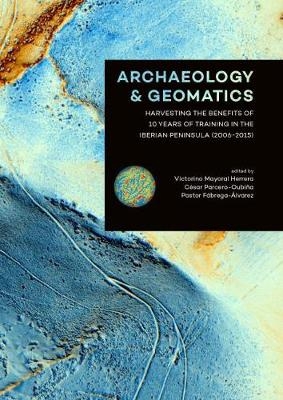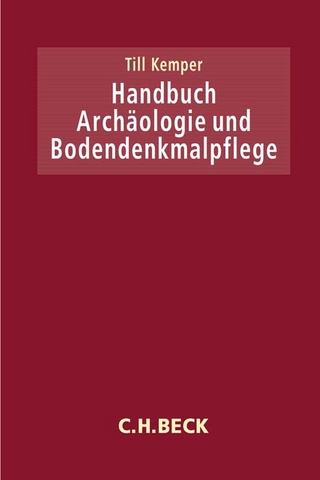
Archaeology and Geomatics
Sidestone Press (Verlag)
978-90-8890-451-6 (ISBN)
In 2005 a (then) pioneering postgraduate course on the applicability of digital geospatial technologies for archaeology was launched in Spain. Quite unexpectedly, the course has been alive annually for more than 10 years so far, having trained around 300 young archaeologists from Spain, Portugal, and Latin America in the critical use of nowadays popular tools such as GIS, GPS, remote sensing and LiDAR for the documentation and analysis of the archaeological record.
To commemorate the first 10 years of the course, a conference was organized in Mérida (Spain) in October 2015. Former students were invited to present and discuss their research in which these technologies were used intensively; this edited book is a selection of those contributions. Through a series of widely varying case-studies, both technically sophisticated and theoretically informed applications of such digital technologies are presented.
All the contributors are young researchers, either young doctors or doctorate students, coming from fairly varied archaeological contexts and approaches.
Dr. Victorino Mayoral Herrera (Madrid, 1970; PhD, 2001, Complutense University of Madrid, Spain). Staff Scientist at the Instituto de Arqueología-Mérida (Merida Institute of Archaeology) (IAM), Consejo Superior de Investigaciones Científicas (Spanish National Research Council) (CSIC) in Spain. Before joining the IAM, he developed his career at the Complutense University of Madrid and in the Heritage Administration of the Autonomous Region of Extremadura. His research has been mainly concerned with an archaeological approach to the study of landscape, with two main vectors. On the one hand, a historical analysis focused on the transition between indigenous cultures and the Roman rule in the Mediterranean, without neglecting the longue durée nature of this kind of research. On the other hand, in methodological terms his efforts have been mainly devoted to the exploration of the potential of non-invasive methods like remote sensing, aerial, geophysical, and especially surface survey with the support of geospatial technologies. Victorino has conducted multiple research projects in Spain. He has authored, among others, Paisajes Agrarios y cambios social en Andalucía Oriental entre los períodos ibérico y romano (2004), Arqueología del trabajo. El ciclo de la vida en un poblado ibérico (2007), and co-edited collective works like Tecnologías de información geográfica y análisis arqueológico del territorio. Actas del V Simposio Internacional de Arqueología de Mérida (2011) and La revalorización de zonas arqueológicas mediante el empleo de técnicas no destructivas (2016). Dr. César Parcero-Oubiña (Santiago de Compostela, 1969; PhD, 2001, University of Santiago de Compostela, Spain). Staff Scientist at the Instituto de Ciencias del Patrimonio (Institute of Heritage Sciences) (Incipit), Consejo Superior de Investigaciones Científicas (Spanish National Research Council) (CSIC) in Spain. Before joining the Incipit, he developed his career at the University of Santiago de Compostela. His research has mainly been concerned with landscape archaeology and has focused on the analysis of the productive, social and political dimensions of later prehistoric societies (the Iron Age in Western Europe, and now the later pre-Hispanic context in South America). He is also interested in the application of geospatial technologies for both archaeology and the wider field of Cultural Heritage. He has carried out fieldwork in Spain, Uruguay and Chile, and collaborated in projects in Ethiopia and Mongolia. César has authored, among others, La construcción del paisaje social en la Edad del Hierro del Noroeste Ibérico (2002) and co-edited A data model for Cultural Heritage within INSPIRE (2014) and Atlas Arqueolóxico da Paisaxe Galega (2016). He is currently Project Officer of the Archaeolandscapes International association and member of the Spanish Spatial Data Infrastructures Working Group. Pastor Fábrega-Álvarez (Ourense, 1978; MA, 2003, University of Santiago de Compostela, Spain). Technical staff member at the Instituto de Ciencias del Patrimonio (Institute of Heritage Sciences) (Incipit), Consejo Superior de Investigaciones Científicas (Spanish National Research Council) (CSIC) in Spain. His fields of interest are the design of methodologies for analyzing and managing archaeological heritage from a geographic and landscape perspective. More specifically, his work is focused on the use of geospatial technologies such as GIS, Remote Sensing and 3D representation techniques for the analysis of the archaeological record. Recently, he has been involved in projects like SPATRIAL and CHARM, which aim to develop conceptual and spatial models of cultural heritage. He has been member of the Spanish Spatial Data Infraestructures Working Group. He has also participated in projects and initiatives related to the archaeological study of ancient landscapes, such as ArchaeoLandscapes Europe and Agriculture and Empire in the High Altitude Atacama Desert (Chile) On all those subjects he has published different contributions in books, conference proceedings and papers in national and international scientific journals.
Introduction
Unboxing the black box. Lessons learnt from ten years of teaching geospatial technologies to archaeologists.
by Victorino Mayoral Herrera, César Parcero-Oubiña and Pastor Fábrega-Álvarez
Section 1. Shapes and locations. Documenting and characterizing the archaeological record
Pursuing ancient rural life through surface survey: composition and diversity of artifact distributions.
by Luis Antonio Sevillano Perea
Experiments on Roman surface scatters through digital survey methods: study cases from Odra-Pisuerga region, (Burgos, Spain).
by Jesús García Sánchez
Scope and limitations of airborne LiDAR technology for the detection and analysis of Roman military settlements in Northwest Iberia.
by José Manuel Costa García and João Fonte
Making Visible the Invisible: Low Cost Methodologies for the Study of Ancient Carvings.
by Miguel Carrero-Pazos, Benito Vilas-Estévez and Alia Vázquez-Martínez
Section 2. Tools and methods. Procedural approaches
Methods for the evaluation of the visualization of archaeological sites
by Pablo Paniego Díaz
Landscapes on the move. Digitally exploring the relationship between megaliths and mobility in Northern Cáceres (Spain).
by Jose M. Señorán Martín
The answer is blowing in the wind: a method to measure wind-protection as a criterion for settlement in the past.
by Marcos García García
Section 3. Patterns, behaviour, decisions. Analysing the archaeological evidence
Application of GIS to flint management studies during the Pleistocene to Holocene transition: the case of Baltzola (Dima, Bizkaia, Spain).
by Maite García-Rojas, Alejandro Prieto, Aitor Sánchez, Cristina Camarero and Lydia Zapata
The Archaeology of Rock Art as Archaeology of the Mediterranean Landscape.
by María Sebatián López
Building landscapes: a landform approach for the Iron Age sites in the Upper Duero River.
by Raquel Liceras-Garrido, Enrique Cerrillo-Cuenca and Alfredo Jimeno-Martínez
GIS contribution to the analysis of the distribution of Roman caves between the Ebro River and the Pyrenees.
by Leticia Tobalina Pulido, Benoît Pace and Alain Campo
The potential of the Geographic Information Techniques for the analysis of the morphology and settlement patterns of the Roman military sites of early imperial era in Iberia.
by José Manuel Costa-García
Centering Tafí: A political approach to the landscape of a Southern Andes Formative community.
by Jordi A. López Lillo
Landscapes of War. GIS applications in the study of the Spanish Civil War.
by Manuel Antonio Franco Fernández and Pedro Rodríguez Simón
Section 4. Archaeology and the public. Disseminating to a wider audience
Geographic Information Systems: an effective tool for the management of the Cultural Heritage of Cantabria.
by Gustavo Sanz Palomera
A map for Gondar. Cartographic system for the touristic development of the Amhara Region (Ethiopia)
by Cristina Charro Lobato, Eduardo Martín Agúndez and Agustín Cabria Ramos
Discussion and comments
by Martijn van Leusen
| Erscheinungsdatum | 18.04.2018 |
|---|---|
| Zusatzinfo | 35fc / 80bw |
| Verlagsort | Leiden |
| Sprache | englisch |
| Maße | 182 x 257 mm |
| Themenwelt | Geisteswissenschaften ► Archäologie |
| ISBN-10 | 90-8890-451-0 / 9088904510 |
| ISBN-13 | 978-90-8890-451-6 / 9789088904516 |
| Zustand | Neuware |
| Haben Sie eine Frage zum Produkt? |
aus dem Bereich


